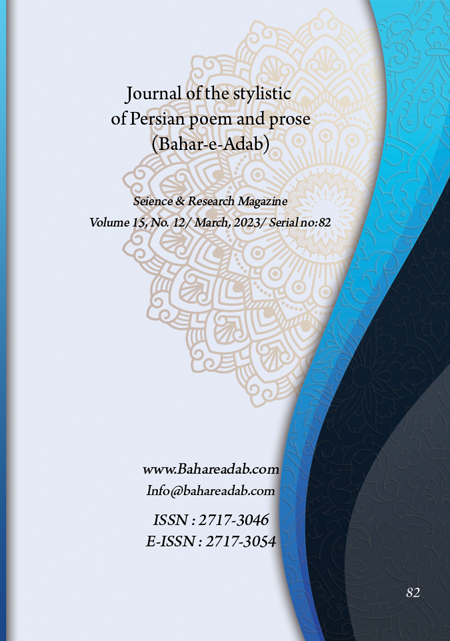- Count View : 283
- آدرس کوتاه شده مقاله: https://bahareadab.com/article_id/1408
- کد doi مقاله: Doi: 10.22034/bahareadab.2023 .15 .6649
Journal of the stylistic of Persian poem and prose
volume Number 15،
number In Volume 12،
،
issue Number 82
Stylistics of Emla Bukhara's divan and introduction of its manuscript
Tahereh Safavinejad , Jalil Nazari (Author in Charge), Mohammad Reza Masoumi
Abstract
BACKGROUND AND OBJECTIVES: Emla Bukhara is one of the mystic poets of the Vararoud region of Central Asia who has undergone a mystical cirrhosis in the service of his elders and has reached the authorities of certainty. His lyric poems are full of mystical terms and mysteries. The purpose of this article is to study the style of Bukhara"s orthography and to introduce its manuscript.
METHODOLOGY: This research was a descriptive-analytical method.
FINDINGS: The poetic style of Emla is more inclined to the Iraqi style and has been greatly influenced by Hafez"s poems; Of course, features of the Indian style can also be found in his poems, which shows that his poems have the characteristics of both Iraqi and Indian styles
CONCLUSION: Linguistically, Emla poetry is very simple and fluent, and the influence of ancient Persian and Arabic is very low. Creative and beautiful compositions, often popular poetry with different and new lines, are other features of his poetry at the linguistic level. Literally, there is a great variety of rhetorical techniques in his poetry. There are almost all kinds of widely used rhetorical techniques in his poetry. In the meanwhile, simile among the expressive industries and puns among the novelty industries have the highest frequency in his poetry. Intellectually, love and mysticism are the two dominant and unique themes in Bukhari"s poetry collection. Rendaneh themes and more or less references to Nir verses and hadiths are other features of his poetry at this level. The lover in Emla’s poetry is like the poems of Hafez; It can be both earthly and celestial. However, it has characteristics such as cruelty, unfaithfulness, rebellion, and inaccessibility.
Keyword
Divan Ghazaliat
, Emla Bukhara
, stylistic features
- The Holy Quran
- Attar Neyshabouri, Farid al-Din. (1960). Attar Neyshabouri's poetry collection, edited by Sa’eed Nafisi, third edition, Tehran: Sanai Library.
- Eeyni, Sadr al-Din. (1926). Sample of Tajik Literature, with Introduction by Abolghasem Lahouti, Moscow: Central Publishing House of the USSR.
- Emla Bukharaei. (2011). Divan, by Habib Safarzadeh, Tehran: Al-Huda.
- Emla Bukharaei. (ND). Manuscript, Library of the Grand Ayatollah Golpayegani, registration number 155/15.
- Emla Bukharaei. (ND). Manuscript, Library of the Islamic Consultative Assembly, Registration No. 374450.
- Emla Bukharaei. (ND). Manuscript, misplaced.
- Hafez Shirazi, Shamsuddin Mohammad. (2021). Poetry Divan, edited by Mohammad Qazvini and Qasem Ghani, Tehran: Zavvar.
- Khorramshahi, Bahauddin. (2021). Hafezname, Volumes 1 and 2, Tehran: Scientific and Cultural.
- Mahmoudzadeh, Abedjan Beyk Nazar. (2017). Delay in Bukhara's spelling and life, Jahanbebin Magazine, (2) 1.
- Mohraram, Nematullah. (1975). Tazkereh al-Shoa'ra, Tajikistan: Doshanbe.

